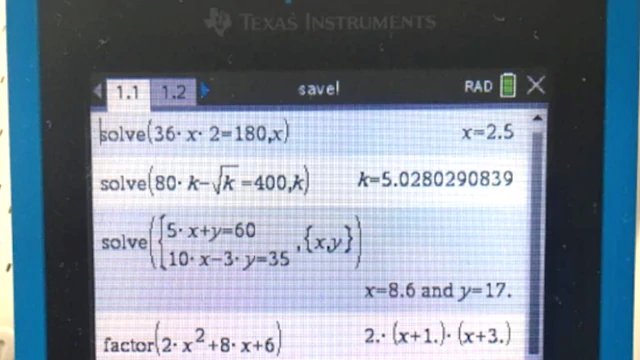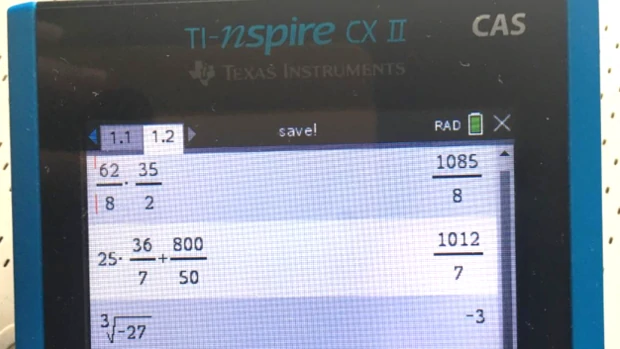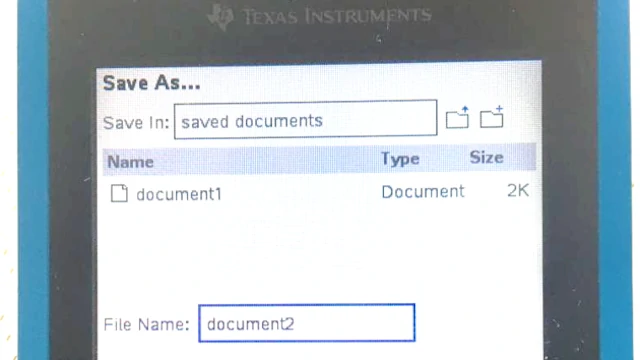CAS calculators are graphing calculators that also contain a Computer Algebra System (CAS). After using both CAS and non-CAS calculators for exams in the past, I’ve heard many queries from people about the differences between these two types of calculators. I put together this list to hopefully help you figure out some of the differences between CAS and non-CAS calculators.
The main advantages of CAS calculators over non-CAS calculators are that they can solve algebra, work with exact form representation of numbers, and handle more complex operations such as storing documents. CAS calculators also typically cost approximately $20 – $50 more than their non-CAS counterparts.

The unique functions of the CAS system distinguish CAS calculators from other graphing calculators, creating a dilemma over which to choose. In this guide, I’ll be outlining the features that set CAS calculators apart from non-CAS calculators to help you decide which is more suitable for your needs.
1. Capable of solving algebra
Solving equations algebraically with little user input is one of the key differences that separates CAS and non-CAS calculators. CAS calculators can solve equations, such as simultaneous and symbolic equations, without needing to re-arrange the equation before entering it into the calculator.
A non-CAS calculator typically needs you to input all lines of solving an equation to find a variable. All a CAS calculator needs is the equation and the variable you need to solve for.
This makes exams easier. It saves you the time it takes to re-arrange and solve an equation; it also reduces your margin for error by reducing the number of steps you need to do to get the answer.

I found the solve function one of handiest things to use on my TI-Nspire CX CAS II when I was sitting exams. All I had to do was choose the solve function, type in the equation and variable needed, and press enter to solve the question – how easy is that!
2. Able to work with exact form
CAS calculators can work with exact form, capable of representing fractions and irrational numbers with exact expressions rather than as decimal approximations. A CAS calculator can give answers in fraction or radical form, whereas a non-CAS calculator typically only gives decimal answers.
Exact answers without approximations can be generated from CAS calculators. This means your answers are more accurate. Some useful numbers for calculation are best represented as fractions, roots, or with other mathematical symbols (I’m looking at you pi). CAS calculators are capable of representing these numbers exactly.

How does a CAS calculator manage to work with exact form? I found there are a couple of reasons: 1) Larger screen, allowing more detail to be displayed, and 2) having the underlying computer-based variables be capable of storing multiple numbers as a representation of a number (e.g. by using an ‘object‘ model for storing each number).
3. Not permitted in as many exams
CAS calculators may be restricted in exams even where other graphing calculators are allowed to be used. Some exams forbid CAS calculators to be used.
The reason behind this is that some education boards believe CAS calculators give the students who use them an unfair advantage. It can change the way mathematical problems are formulated, and change the focus of what the student is being examined on.
If you’re planning on buying a CAS calculator for exam use, be sure to check the exam material guidelines before you make the decision.
I surveyed a few country’s examination boards to see where CAS calculators were accepted and found the following:
- In the USA, CAS calculators are generally permitted in exams, except for the ACT. According to the ACT guidelines, CAS calculators are prohibited because “the ACT mathematics test does not assess” the student’s ability to use a CAS calculator.
- In Australia, CAS calculators are prohibited in QCAA, SACE, and HSC exams. Other states have exams which can be taken using a CAS calculator.
- In the UK, CAS calculators are prohibited for GCSE and A-Level exams.
- International Baccelaureate examinations only permit CAS calculators that have the option to disable the CAS functions, or to enable an exam mode.
4. More expensive
CAS calculators typically cost $20 – $50 more than their non-CAS counterparts. This is due to CAS calculators having more features and functions, including that they often have a better screen.
I’ve listed a few of the most popular CAS calculators below and compared their price to popular non-CAS calculators:
| Calculator Brand | CAS Cost | Non-CAS cost |
|---|---|---|
| Texas Instruments | $140 – $195 | $125 – $145 |
| Casio | $173 – $195 | $150 – $170 |
| HP | $187 | – |
For Texas Instruments, I compared the TI-Nspire CX II CAS against its non-CAS brother (TI-Nspire CX II). For Casio, I compared the Classpad FX-CP400 against the FX-CG50 and FX-CG20. For HP, this reference is for the HP Prime Graphing calculator. Prices are taken from Amazon, Casio, Abacus Calculators, Staples, Best Buy, Walmart, and Officeworks.
5. More complex
CAS calculators can be more difficult to figure out when first starting to use them. This is due to their wider range of features and functions. It took me a lot of trial and error to wrap my head around all of the options when I first started.
When you start out with a CAS calculator, the user manual will be your best friend (trust me). Make sure you have access to this – it’ll save you a lot of time learning the buttons and controls without guidance. Each calculator is unique, meaning that a TI manual may not help you learn how to use a Casio calculator.
If you’re still confused, or you lost the manual, I found YouTube to be a great source of learning for CAS calculators. I found this video and this video really helpful when learning how to use my TI-Nspire CX II.
CAS calculators can be especially difficult if you don’t have the mathematical knowledge to understand the functions involved. While I was using my CAS calculator to help me learn mathematics, I did hear that CAS calculators probably can’t help students with a poor mathematical foundation.
6. More memory
CAS calculators typically have more memory and storage than non-CAS calculators. This can allow you to store more data on the calculator, and even create and save documents to the calculator memory.

This feature is more useful than it first seems – whenever I got stuck on an exam question, I saved what I had already done and moved on. From there, I could come back to the question later and still have all of my working out.
7. Advantage in exams
Finally, what truly sets CAS calculators apart, is the advantage they have over non-CAS calculators. The CAS functionality make complicated algebra equations incredibly simple, giving them a valuable edge over more traditional calculators. In fact, TestPrepHQ says that the extensive range of CAS features make using a CAS calculator so easy that it “almost feels like cheating”.
CAS calculators can have some disadvantages though, particularly when it comes to learning mathematical concepts. Reliance on CAS calculators can lead to students breezing through classwork and exams without actually learning the material. A student may very well learn to use the CAS calculator to solve equations without putting any stock into the pen-and-paper tactics that would be used.
